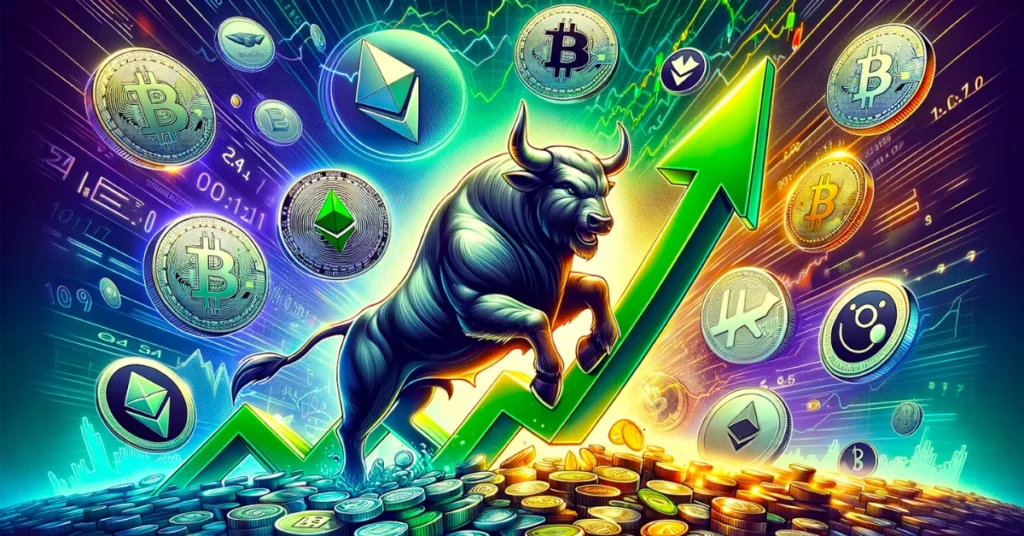Introduction to Altcoins
The crypto currency market is a realm of constant evolution, characterized by its volatility and rapid shifts in dynamics. Among the most intriguing phenomena in this market are altcoins, or alternative cryptocurrencies to Bitcoin, and the cyclical nature of their performance known as “altcoin seasons.” With the onset of 2024, many investors and analysts are keenly observing the potential for a new bull run and its implications for altcoins.

Table of Contents
What Are Altcoins?
“Altcoin” stands for “alternative coin,” encompassing any cryptocurrency other than Bitcoin. Since Bitcoin’s creation in 2009, thousands of altcoins have emerged, each offering unique features or improvements. These can be broadly categorized into:
Forks of Bitcoin: These are variations of Bitcoin that have altered features or rules. Examples include Bitcoin Cash (BCH) and Bitcoin SV (BSV).
Platform Coins: Designed to support decentralized applications (d Apps) and smart contracts, platform coins include Ethereum (ETH), Cardano (ADA), and Polka dot (DOT).
Stable coins: Pegged to stable assets like fiat currencies to reduce volatility, stable coins include Tether (USDT) and USD Coin (USDC).
Privacy Coins: Focused on enhancing transaction privacy, privacy coins include Monero (XMR) and Zcash (ZEC).
Utility Tokens: Used within specific ecosystems for accessing services or governance, utility tokens include Binance Coin (BNB) and Chainlink (LINK).
Understanding Altcoin Seasons
An “altcoin season” is a period when altcoins experience substantial price gains relative to Bitcoin. This phenomenon often follows a period of strong performance by Bitcoin, where investor capital begins to flow into altcoins, leading to their outperformance.

Indicators of an Altcoin Season
Bitcoin’s Market Behaviour:
Altcoin seasons typically follow a phase where Bitcoin has achieved new highs and starts to consolidate or grow at a slower pace. Investors may then shift focus to altcoins in search of higher returns.
Decrease in Bitcoin Dominance:
Bitcoin dominance measures Bitcoin’s market capitalization as a percentage of the total cryptocurrency market. A decrease in Bitcoin dominance, which can be tracked through platforms like Coin Market Cap, often signals that investment is moving towards altcoins.
Increased Altcoin Activity:
During an altcoin season, many altcoins see significant price movements and higher trading volumes. New projects and tokens often emerge, attracting investor attention.
Market Sentiment:
Positive market sentiment and speculative interest drive altcoin seasons. As Bitcoin stabilizes or consolidates, altcoins may gain traction due to heightened enthusiasm and media coverage.
Characteristics of Altcoin Seasons
Volatility:
Altcoins generally exhibit greater volatility compared to Bitcoin. This volatility can lead to substantial gains but also entails higher risk.
Innovation and Speculation:
Altcoin seasons are often accompanied by technological advancements and major announcements in the altcoin space, which can fuel speculation and drive investment.
Diverse Opportunities:
With a wide range of altcoins available, investors can explore diverse investment opportunities tailored to various use cases and industries.
The 2024 Bull Run: An Overview
A “bull run” in cryptocurrency refers to a sustained period of rising prices, characterized by optimism and increased trading activity. The year 2024 is shaping up to be a pivotal moment for the cryptocurrency market, with several factors potentially driving a new bull run.
Factors Contributing to the 2024 Bull Run
Bitcoin’s Halving Event:
Historically, Bitcoin halving events—where the reward for mining Bitcoin is cut in half—have been followed by significant price increases. The next Bitcoin halving is expected to occur in early 2024, which could set the stage for a new bull run.
Institutional Adoption:
Increased institutional adoption of cryptocurrencies could drive market momentum. Major financial institutions and corporations are showing growing interest in digital assets, potentially contributing to a bull run.
Technological Advancements:
Innovations in blockchain technology, such as upgrades to Ethereum and the development of new layer-2 solutions, can drive investor interest and market growth.
Regulatory Developments:
Positive regulatory developments and clearer frameworks for cryptocurrencies could boost investor confidence and stimulate market growth.
Market Sentiment:
A combination of positive news, favorable economic conditions, and growing public awareness can contribute to a bullish market sentiment, driving up prices.
The Relationship Between Bull Runs and Altcoin Seasons
Bull runs often create the conditions for altcoin seasons. Here’s how:
Initial Bitcoin Rally:
A bull run usually begins with a strong rally in Bitcoin’s price. This initial surge draws significant attention and investment, leading to increased Bitcoin dominance.
Transition to Altcoins:
As Bitcoin’s price reaches new highs and starts to consolidate, investors may look for higher returns in altcoins. This shift can trigger an altcoin season, where altcoins start to outperform Bitcoin.
Spill over Effect:
During the later stages of a bull run, the positive sentiment and increased liquidity in the market can spill over into altcoins, driving their prices higher and leading to a period of heightened altcoin performance.
Historical Context: Previous Bull Runs and Altcoin Seasons
2017 Bull Run:
The bull run of 2017 saw Bitcoin reaching nearly $20,000 by December. As Bitcoin’s price surged, altcoins such as Ethereum, Ripple (XRP), and Litecoin experienced significant gains, marking a classic altcoin season.
2020-2021 Bull Run:
The bull market of late 2020 and early 2021 saw Bitcoin reaching new all-time highs, followed by a strong altcoin season. Ethereum, Binance Coin, and Solana were among the top performers during this period.

Risks and Considerations for the 2024 Bull Run
Investing in cryptocurrencies during a bull run and altcoin season presents significant opportunities but also comes with risks. Here are some considerations for investors:
Volatility and Risk Management:
The high volatility of altcoins can lead to substantial gains or losses. Effective risk management strategies, such as setting stop-loss orders and diversifying investments, are crucial.
Due Diligence:
Thorough research is essential when evaluating altcoins. Investors should assess the technology, team, use case, and market potential of any altcoin before investing.
Market Sentiment and Timing:
Market sentiment can change rapidly. Staying informed about market trends and being prepared to adapt to shifting conditions is important for navigating bull runs and altcoin seasons.
Regulatory Risks:
Regulatory developments can impact the value and legality of cryptocurrencies. Keeping abreast of regulatory changes and their potential effects on the market is essential for managing investment risks.
